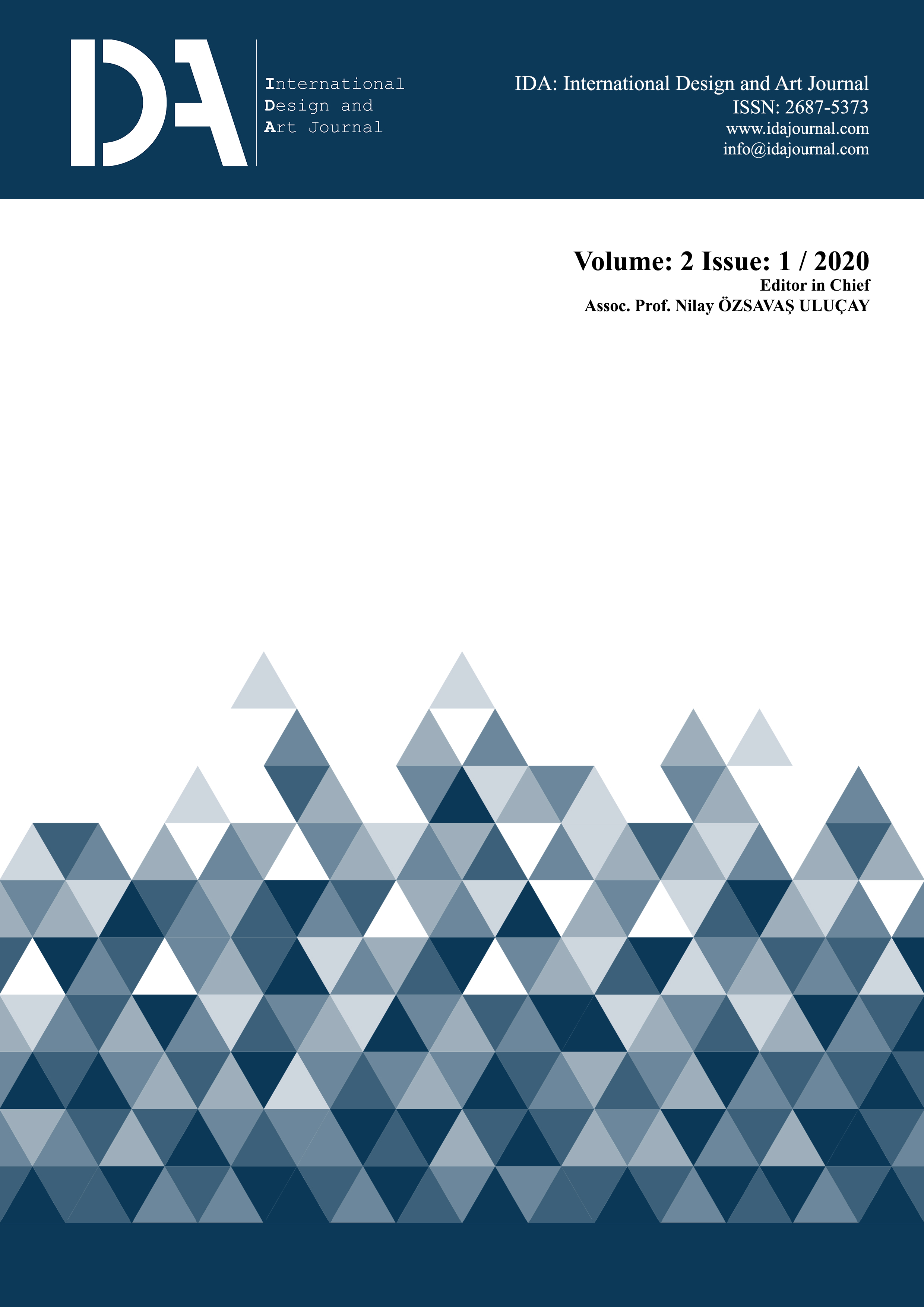Eko-Tek Kent Modelinde İç Mekan Tasarımı
Anahtar Kelimeler:
Eko-Tek Kentler- Eko-Tek Mekân Tasarımı- Eko-TeknolojilerÖzet
Ekoloji ve teknoloji kavramlarının birleşimlerinden oluşan eko-tek tasarım anlayışı, günümüz tasarım stratejilerinin çevre sorunlarına mekân ölçeğinde bir çözüm getirememesi sebebiyle ihtiyaç olarak doğmuştur. Çevre sorunlarına karşı bilinçlenme ile yapısal alan ve doğal çevre arasındaki ilişkilere dikkat çekmektedir. Eko-tek kavramı, teknolojik araçlar yardımıyla ekolojinin en iyi şekilde korunmasını ifade etmektedir. Ekoloji ve teknolojinin birlikte düşünülmesi ile sürdürülebilir bir yaşamı sağlamak adına, doğal elemanları, doğal süreçleri temel almakta, doğanın korunması için teknolojiden yararlanılması gerektiğini savunmaktadır. Çalışmada ekoloji ve teknoloji merkezli tasarımı aynı başlık altında buluşturma fikri amaçlanmaktadır. Bu kapsamda kent ölçeğinde bir karşılığı bulunan eko-tek kent modeli incelenmiş ve eko-tek mekânlara bir bakış geliştirilmiştir. Çalışmanın cevabını aradığı soru “eko-tek kent modelinde gelişecek mekân tasarımında ekoloji ve teknoloji arasında bir seçim yapmadan nasıl mekân tasarlar?” sorusudur. Bu kapsamda tasarlanan yapılar ve iç mekânlar enerji verimli, ekolojiye duyarlı ve birçok teknoloji sistemini bünyesinde barındırmaktadır. Yüksek lisans tez çalışmasından üretilmiş olan makale kapsamında geleceğin tasarım anlayışını oluşturan eko-tek kavramı mekân ölçeğinde ele alınmıştır. Bu süreçte eko-tek kentler kavramın genel çerçevesinin oluşmasında yol gösterici olmuştur. Literatür taraması sonucunda eko-tek kavramına yönelik bir bakış oluşturulmuş ve bu kavram kapsamında kullanılan dört teknoloji sistemi ele alınmıştır. Çevre, bilgi, iletişim ve coğrafi bilgi teknolojilerinin tasarıma katkıları ekolojik boyutta değerlendirilmiştir. Kavramın mekânsal ölçekte değerlendirilmesi adına dünyanın farklı bölgelerinden seçilen beş adet örnek eko-tek kavramı doğrultusunda analiz edilmiştir. Eko-tek kavramı kapsamında oluşturulabilecek iç mekân özellikleri örnekler üzerinden incelenmiştir. Sonuç olarak kavrama genel bir bakış oluşturulmuş, altı ana başlıkta eko-tek tasarım süreci ele alınmıştır. Süreç, sosyolojik etmenler, bölgesel veriler, eko-teknolojiler, akıllı sistemler ve malzeme başlıkları eko-tek kavramının sürecini tanımlamaktadır. Kavramsal süreç iç mekân ölçeğinde değerlendirilmiş ve iç mekânların eko-tek özelliği taşıması için sekiz madde oluşturulmuştur. Bu maddeler geleceğin iç mekânlarının niteliğini ve işlevlerini belirlemektedir. Eko-tek kavramı dünyada çözümü aranan çevre sorunlarına ve kaynak problemlerine yapı ve iç mekân ölçeğinde katkı sağlamaktadır.
Referanslar
Abdollahi, M. (2016). The Impact of Sustainable Development on Eco-Tech Architecture. Bulletin de la Société Royale des Sciences de Liège. İran. Vol. 85, 1371-1377. https://popups.uliege.be/0037-9565/index.php?id=6110&file=1 (09.09.2019)
Avcı Architects. https://avciarchitects.com/tr/proje/tmb-merkez-binasi/ (05.12.2019)
Bogunovich, D. (2002). Eco-tech Cities: Smart Metabolism for a Green Urbanism. Brebbia C.A.(ED). The Sustainable City II. Martin-Duque&L.C. Wasdhwa. S. 75-84. London: Witpress.
Bookchin, M. (1980). Ekolojik Bir Topluma Doğru (Toward an Ecological Society). İstanbul: Sümer Yayıncılık.
Enric Ruiz Geli Team. https://www.ruiz-geli.com/projects/built/media-tic (05.12.2019)
Ercoşkun, Ö. Karaaslan, Ş. (2009). Geleceğin Ekolojik ve Teknolojik Kentleri, Megaron YTÜ Mim. Fak. E-Dergisi. İstanbul. 3(3), 283-296. http://www.journalagent.com/megaron/pdfs/MEGARON-30932-ARTICLE-YALCINER_ERCOSKUN.pdf (21.07.2019)
Hugh Broughton Architects. https://hbarchitects.co.uk/halley-vi-british-antarctic-research-station/ (05.12.2019)
Iranmanesh, L., Nakhaine, H. (2011). Study of the Roles of Eco-tech Architecture in Development of Tourism Industry. 2nd International Conference on Business, Economic and Tourism Management. Singapore. Vol.24, 61-66. http://www.ipedr.com/vol24/13-CBETM2011-M10015.pdf (14.10.2019)
Mozhdegani, A. S., Afhami, A. (2017). Using Ecotech Architecture as an Effective Tool for Sustainability in Construction Industry. Engineering,Technology & Applied Science Research. Iran. Vol.7, 1914-1917.https://pdfs.semanticscholar.org/3d1f/b15e84fa842fba58706f7eb8dabacb4d0f4d.pdf (22.09.2019)
Nazarian, T. (2015). The Common Language of Sustainable Architecture in Creating New Architectural Spaces, International Journal of Science, Technology and Society. İran. Vol.3, No.2-1, 47-51. https://www.researchgate.net/publication/316299092_The_Common_Language_of_Sustainable_Architecture_in_Creating_New_Architectural_Spaces (09.09.2019)
Snohetta. https://snohetta.com/projects/366-svart# (05.12.2019)
SOM. https://www.som.com/projects/the_kathleen_grimm_school (05.12.2019)
Yeang, K. (2012). Ekotasarım Ekolojik Tasarım Rehberi. İstanbul: YEM Yayınları.
Yıldız, P. (2014). İç Mimarlıkta ‘Yapay Zekâ’ ve Türkiye’den Seçilmiş Örneklerin Mekân Tasarımı Yönünden Kapsamlı Analizi Çalışması. Ankara: Hacettepe Üniversitesi Yayınları.
Zandieh, M., Nikkhah, A. (2015). Architecture of Buildings Using Renewable Energies in Harmony with Sustainable Development. Jurnal UMP Social Sciences and Technology Management. Vol.3 Issue.2, 27-33. https://pdfs.semanticscholar.org/1e72/fb2be9dc84bd7b98df2744674328774e364b.pdf (10.05.2019)
İndir
Yayınlanmış
Sayı
Bölüm
Lisans
IDA: International Design and Art Journal açık erişimli akademik bir dergidir. Kabul edilen makalelerin tüm yayın hakları IDA: International Design and Art Journal'a devredilmiş sayılır. Makaleler başka bir yerde yayınlanamaz, kopyalanamaz ve referans göstermeden kullanılamaz.

IDA: International Design and Art Journal Creative Commons Atıf-GayriTicari-AynıLisanslaPaylaş 4.0 Uluslararası Lisansı ile lisanslanmıştır.


